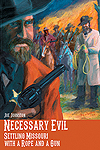
Necessary Evil: Settling Missouri With a Rope and a Gun, by Joe Johnston, Missouri History Museum Press, St. Louis, 2014, $24.95
Nineteenth-century Missouri spanned the divide where Eastern law and order petered out and the untamed lawless frontier began. Missouri native Joe Johnston says that in the early 1800s veterans of the Revolutionary War, War of 1812 and Black Hawk War flooded to the region, created as Louisiana Territory on July 4, 1805, and renamed Missouri Territory in 1812. These battle-hardened men were mostly earnest settlers, but with them came grifters, burglars and “the kind of rattlesnake who’d look a man in the eye while stabbing him in the back.” The first U.S. marshal didn’t arrive until 1822 (a year after Missouri became a state), and the state didn’t merit a second marshal until 1857, while local law enforcement remained spotty. “When the law fell short, the people administered justice,” Johnston writes in his introduction. And these men didn’t wear badges. “Beautiful Missouri,” the author adds, “gave birth to one generation after another of threatening, property-destroying, gun-slinging enforcers of the law, as they understood the law.”
Johnston’s book centers on Missouri’s vigilantes, some of whom acted alone but most in mobs, and their reliance on the rope (the kind with a noose at one end) and the gun. The Mormon wars of the 1830s left, according to Johnston, “an entire generation schooled in vigilantism and empowered by government to take the law into their own hands.” A band of vigilantes called the Slickers followed, and many of them became overzealous in their acts of intimidation and violence. The border clashes, marked by guerrilla warfare, spawned many angry young men who after the Civil War chose to continue as self-appointed enforcers ready at the drop of a hat to defend their rights and homes. Later came the Bald Knobbers, a vigilante group bent not only on vengeance and punishment but also crime prevention. The group’s harsh methods led to the rise of the Anti–Bald Knobbers, and it was vigilantes against vigilantes. Amid these action-packed tales such familiar figures as Jesse James, Wyatt Earp and Wild Bill Hickok played roles. Some vigilantes might seem heroic for rising above the law (or lack of law) to defend the people (or at least like-minded people), while others might be portrayed as villains. The bottom line for the author, though, is that “Missouri could not have been settled without its vigilantes.”
Editor




